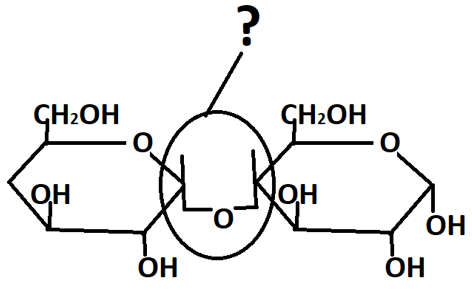This set of Class 11 Biology Chapter 9 Multiple Choice Questions & Answers (MCQs) focuses on “Biomolecules – Polysaccharides – 2”.
1. Identify the structure.

a) Hydrogen bond
b) Ether formation
c) Ketone formation
d) Glycosidic bond
View Answer
Explanation: The structure shown contains two glucose molecules linked to each other. The bond between them is known as a glycosidic bond. It is a covalent bond which is formed between a hemiacetal or hemiketal group of a sugar and the hydroxyl group of some compound.
2. Which of these is a branched polysaccharide?
a) Sucrose
b) Cellulose
c) Glycogen
d) Chitin
View Answer
Explanation: Glycogen is a homopolymer of glucose monomers. It is highly branched. Sucrose is a disaccharide. Cellulose and chitin are both polysaccharides but they are unbranched or linear in structure.
3. What is the shape of the secondary structure of starch?
a) Spherical
b) Linear
c) Helical
d) Branched
View Answer
Explanation: Starch is a polymer made of glucose monomers. It is a polysaccharide. The secondary structures of starch have a helical structure. Starch is the main energy storing polysaccharide in plants.
4. Which molecule can starch hold in its helix?
a) Iodine
b) DNA
c) Amylopectin
d) Cellulose
View Answer
Explanation: Starch can hold iodine molecules in its helix. The secondary structure of starch is in the form of a helix. Starch is a polysaccharide made of glucose monomers. It is an energy storing polysaccharide in plants.
5. In which part of the starch chain is iodine incorporated?
a) Left non-reducing end
b) Right reducing end
c) Helix
d) Branched portion
View Answer
Explanation: Iodine is incorporated into the helix of the starch chain. Starch is a polysaccharide made of glucose monomers. The secondary structure of starch is in the form of a helix, where iodine molecules are incorporated.
6. What color is the starch-iodine complex?
a) Yellow
b) Brick red
c) Blue
d) Black
View Answer
Explanation: The starch-iodine complex has a characteristic blue color. This presence of color serves as a test for the detection of starch in a sample. On addition of iodine solution, if the sample turns blue then the presence of starch is confirmed.
7. Which of these molecules can hold iodine molecules?
a) Starch
b) Cellulose
c) Chitin
d) Sucrose
View Answer
Explanation: The secondary structure of starch is helical and can hold iodine molecules in its structure. Cellulose and chitin do not have helices and hence cannot hold iodine. Sucrose is a disaccharide.
8. The absence of which structure in cellulose does not allow it to hold iodine molecules?
a) Branches
b) Left non-reducing end
c) Right reducing end
d) Helix
View Answer
Explanation: Iodine molecules are held in helices of polysaccharide structures such as starch. The secondary structure of starch is helical and can hence hold starch. Cellulose has a linear structure and thus, cannot hold iodine molecules.
9. What is the main component of the plant cell wall?
a) Lipids
b) Glycogen
c) Cellulose
d) Peptidoglycan
View Answer
Explanation: The plant cell wall is made of cellulose. It is not digestible by humans. Glycogen is a storage carbohydrate in animals. Lipids make up cell membranes. Peptidoglycan is found in the covering of bacteria.
10. Cotton fiber is made of cellulose. True or false?
a) True
b) False
View Answer
Explanation: Cotton fibers are long threads of the polysaccharide cellulose. Cellulose is the most abundant organic polymer in the world. It also makes up the cell wall of plant cells. It is a linear polymer.
11. Which of these structures do not contain cellulose as its major constituent?
a) Cotton fibers
b) Plant cell wall
c) Jute
d) Fungal cell wall
View Answer
Explanation: Cellulose is a homopolymer made of glucose monomers. Cotton fibers, the cell walls of plants and jute are all primarily made of cellulose. However, the fungal cell wall is made of the polysaccharide chitin.
12. Chitin is a _____
a) monomer
b) heteropolymer
c) homopolymer
d) dimer
View Answer
Explanation: Chitin is a polysaccharide made of monomers of N-acetyl glucosamine, which is a modified sugar. It is the main component of the cell walls of fungi and the exoskeleton of arthropods.
13. Which of these is a complex polysaccharide?
a) Glycogen
b) Inulin
c) Chitin
d) Starch
View Answer
Explanation: The polysaccharides glycogen, inulin and starch are simple polysaccharides. Chitin is a complex polysaccharide. Chitin is a homopolymer made of repeating monomers of N-acetyl glucosamine, which is a modified sugar.
14. What is the main constituent of the exoskeleton of arthropods?
a) Chitin
b) Cellulose
c) Glycogen
d) Starch
View Answer
Explanation: Chitin is the main constituent of the exoskeleton of arthropods and also of fungal cell walls. It is a complex polysaccharide. Cellulose makes up plant cell walls, glycogen is a storage polysaccharide in animals while starch is the storage polysaccharide in plants.
15. Which of these statements is not true regarding polysaccharides?
a) Inulin is a polysaccharide made of fructose
b) Chitin is a heteropolymer
c) Glycogen is a highly branched polysaccharide
d) Cellulose makes up cotton fibers
View Answer
Explanation: Inulin is a homopolymer of repeating units of the monomer fructose. Glycogen is highly branched. Cellulose is the major component of cotton fibers. However, chitin is a homopolymer of N-acetyl glucosamine units.
Sanfoundry Global Education & Learning Series – Biology – Class 11.
To practice all chapters and topics of class 11 Biology, here is complete set of 1000+ Multiple Choice Questions and Answers.
If you find a mistake in question / option / answer, kindly take a screenshot and email to [email protected]
- Practice Class 11 - Physics MCQs
- Practice Class 11 - Chemistry MCQs
- Practice Class 12 - Biology MCQs
- Practice Class 11 - Mathematics MCQs
- Check Class 11 - Books
